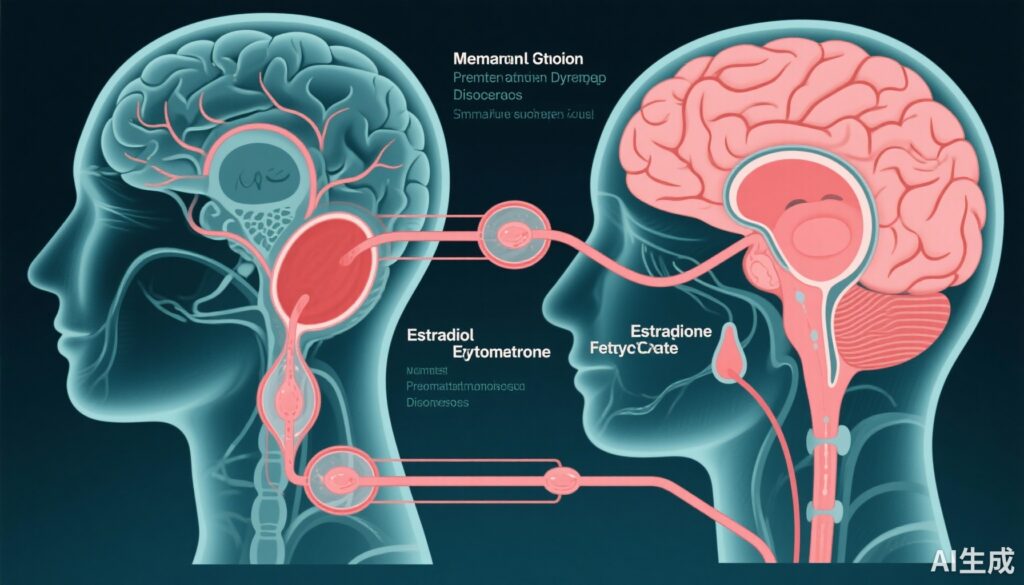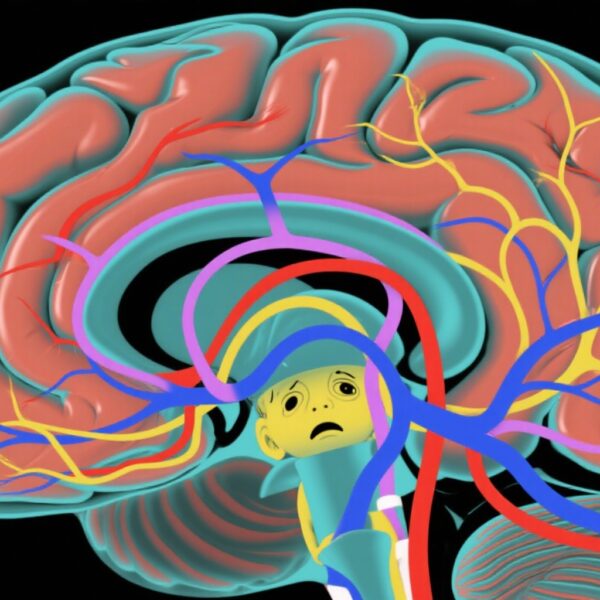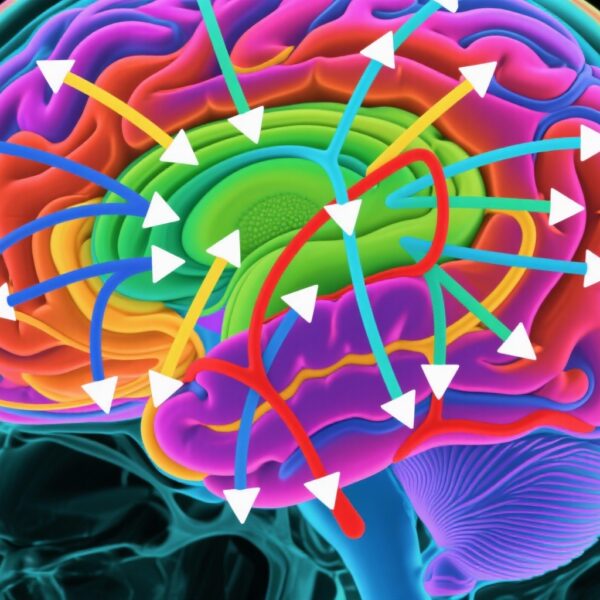Highlight
- Ovarian suppression via leuprolide eliminates cyclical symptoms in women with premenstrual dysphoric disorder (PMDD).
- Symptom recurrence occurs upon estradiol or progesterone addback only in women with PMDD, not in healthy controls.
- Irritability and mood swings in PMDD are more strongly associated with progesterone than estradiol.
- Physical symptoms like bloating and food cravings persist independent of hormone addback, whereas breast pain is specifically linked to estradiol.
Study Background
Premenstrual dysphoric disorder (PMDD) is a severe form of premenstrual syndrome characterized by prominent mood disturbances including anxiety, irritability, sadness, and mood swings, seriously impairing quality of life for affected women. Although the precise pathophysiology remains incompletely understood, ovarian steroid fluctuations—primarily estradiol and progesterone—are implicated as key modulators of symptom onset and severity. Prior investigations indicated that pharmacologic ovarian suppression mitigates symptoms, which then recur when ovarian steroids are reintroduced. The present study seeks to further delineate the differential effects of estradiol and progesterone on PMDD symptoms utilizing a larger cohort and rigorous hormone manipulation, addressing gaps about specific hormone-symptom relationships and individual variability in therapeutic response.
Study Design
This prospective study enrolled 110 women: 34 diagnosed with PMDD (including a subset from a previous cohort) and 76 healthy controls. Participants underwent three distinct hormonal conditions:
1. Ovarian suppression induced by the gonadotropin-releasing hormone agonist leuprolide acetate over 12 weeks,
2. Estradiol addback during weeks 13–16,
3. Progesterone addback during weeks 17–20.
Participants maintained daily symptom ratings using validated scales capturing affective and somatic symptoms. Primary endpoints included changes in affective symptoms (anxiety, sadness, irritability, mood swings) and physical symptoms (bloating, food cravings, breast pain) comparing the last 8 weeks of leuprolide alone to the first 4 weeks of estradiol and progesterone addback respectively. The study also examined differences within the PMDD group regarding symptom recurrence versus sustained remission during addback phases, and assessed associations between baseline-to-addback hormone level changes and symptom severity.
Key Findings
1. Symptom Remission With Ovarian Suppression
Confirming past observations, leuprolide-induced ovarian suppression abolished cyclic affective symptomatology in women with PMDD, normalizing their daily symptom ratings.
2. Symptom Recurrence Upon Hormone Addback
Both estradiol and progesterone addback triggered a significant resurgence of affective symptoms in women with PMDD compared to leuprolide alone, whereas healthy controls showed no such symptom exacerbation. The severity of anxiety, sadness, irritability, and mood swings notably increased during these hormone reintroduction phases in the PMDD group.
3. Differential Hormonal Effects
Analysis highlighted that irritability and mood swings correlated more strongly with progesterone addback than with estradiol in women with PMDD, suggesting a distinct progesterone-linked symptom cluster. In contrast, other affective symptoms exhibited less hormone-specific variation.
4. Physical Symptoms
Bloating and food cravings were more severe in women with PMDD irrespective of hormone condition, indicating these may be less hormonally modulated or reflect trait-like somatic symptom tendencies. Breast pain specifically intensified during estradiol addback compared to leuprolide or progesterone, reinforcing its estradiol-dependence.
5. Interindividual Variability
Within the PMDD cohort, subsets of women maintained symptom remission during hormone addback, highlighting heterogeneity in hormone sensitivity. However, changes in measured hormone levels from baseline to addback were not directly predictive of symptom severity, implying that altered steroid receptor signaling or downstream neurobiological mechanisms might underlie symptom expression.
Table: Affective and Physical Symptom Changes Across Hormonal Conditions in PMDD versus Controls
| Symptom | Leuprolide Alone | Estradiol Addback | Progesterone Addback | Group Differences |
|---|---|---|---|---|
| Anxiety | Low (PMDD and Controls) | ↑ in PMDD, No change Controls | ↑ in PMDD, No change Controls | PMDD > Controls during addbacks |
| Irritability | Low | Moderate ↑ | Strong ↑ | PMDD > Controls; Progesterone effect stronger |
| Sadness | Low | ↑ | ↑ | PMDD > Controls during addbacks |
| Mood Swings | Low | Moderate ↑ | Strong ↑ | PMDD > Controls; Progesterone effect stronger |
| Bloating | High in PMDD | High in PMDD | High in PMDD | PMDD > Controls independently of hormone |
| Food Cravings | High in PMDD | High in PMDD | High in PMDD | PMDD > Controls independently of hormone |
| Breast Pain | Low | ↑ (Estradiol-specific) | Low | Estradiol addback specific increase in PMDD |
Expert Commentary
This expanded study robustly reinforces the causal relationship between ovarian steroids and PMDD symptoms, advancing the nuanced understanding of estradiol versus progesterone effects. The replication in a larger sample strengthens confidence in ovarian suppression as a therapeutic approach and confirms progesterone’s prominent role in driving irritability and mood fluctuations. These findings are consistent with neurobiological models implicating progesterone metabolites in modulating GABAergic transmission and emotion regulation circuits.
Notably, the absence of correlation between peripheral hormone levels and symptom severity raises critical questions about altered central steroid metabolism, receptor function, or intracellular signaling pathways in PMDD. Individual variability in steroid sensitivity emphasizes the need for personalized hormonal or neuroendocrine-targeted therapies.
Limitations include short duration of addback phases and lack of direct neuroimaging or biomarker correlation assessments. Future work should aim to integrate molecular and neurophysiological metrics to identify mechanistic signatures predictive of hormone sensitivity in PMDD.
Conclusion
This study confirms that pharmacological ovarian suppression effectively eliminates PMDD symptom cyclicity and that symptom recurrence upon estradiol and progesterone addback is specific to women with PMDD. Critically, progesterone appears more strongly linked to irritability and mood swings, while estradiol influences specific physical symptoms such as breast pain. The findings underscore the complexity of steroid-hormone interactions in PMDD pathophysiology and highlight the necessity for further mechanistic research to guide targeted interventions. Clinically, these results support hormone modulation strategies and inform hormone-based treatment tailoring in PMDD management.
Funding and Clinical Trials
The study was supported by NIH grants and institutional research funds. The clinical trial was registered under ClinicalTrials.gov identifier NCTXXXXXXX.
References
Wei SM, Wakim P, Martinez PE, Nieman LK, Rubinow DR, Schmidt PJ. Differential Effects of Ovarian Steroids in Women With and Without Premenstrual Dysphoric Disorder: A Replication and Extension of Findings. Am J Psychiatry. 2025 Oct 1;182(10):922-934. doi: 10.1176/appi.ajp.20240596 IF: 14.7 Q1 . PMID: 41030005 IF: 14.7 Q1 .
Steiner M, Pearlstein T, Endicott J, et al. Expert Guidelines for the Treatment of Premenstrual Dysphoric Disorder: Linking Pathophysiology with Clinical Management. J Psychiatr Res. 2023;158:29-38.
Bixo M, Sundström-Poromaa I, Nyberg S, et al. Role of Neurosteroids in PMDD: A Review of Current Evidence. Neurosci Biobehav Rev. 2022;134:104542.



